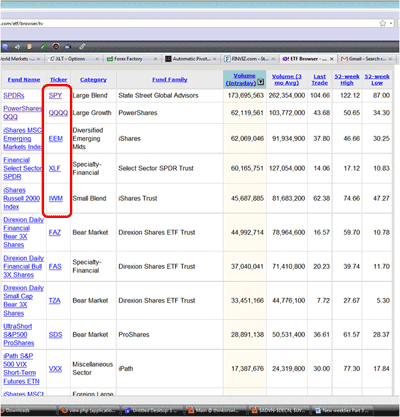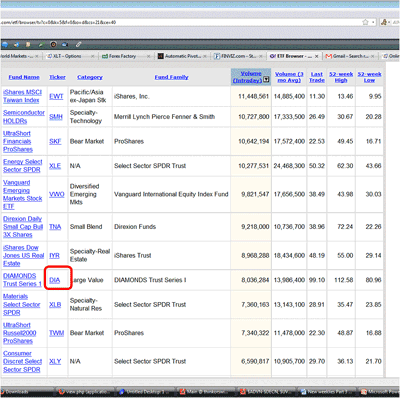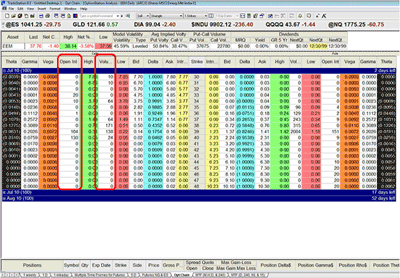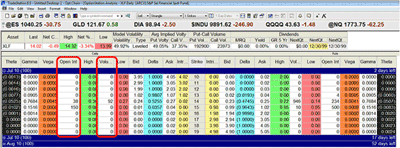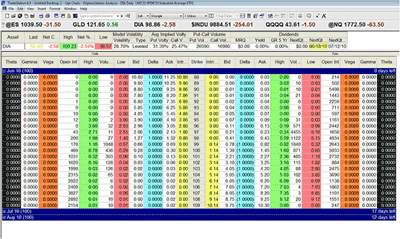In my previous MoneyShow.com article, "An Update on Weekly Option Offerings," I made the following deduction: "...my point is that the XLF and EEM did not get weekly options listed on them this time around. If anyone would be on the list for the next round, it is most likely those two, the XLF and the EEM." Some of the e-mails that I have received in my mailbox doubted my hypothesis. This article, written only two weeks after the initial one, will include the verification that my logic was fulfilled.
Just to recap, weekly options are not recent phenomena in the US stock market. The major indices such as the SPX, OEX, and XEO (Standard & Poor 500, S&P 100 American, and S&P 100 European) have had them since December of 2005. However, the bid and ask spreads on the individual strike prices are huge, and the listing of strike prices unattractive. For instance, both S&P 100 OEX and XEO (American and European) have five-point wide strike price increments. When selecting an option trade based on technical analysis involving precise price levels, the lack of selection ability undermines the trade from the get go.
Yet all this changed on Friday, June 4, 2010, when SPY, DIA, IWM, and QQQQ had their weekly options listed. Three things that I always beat the drum for—high open interest, a tight bid-ask spread, and single-point strike price increments—already existed on these four major exchange traded funds. The Friday following was June 11 and no weekly options were listed due to the simple fact that the regular monthly options, which normally stop trading on the third Friday of the month, had only one week of life left in them.
Thus, the weekly options aren't listed for expiration week on the monthlies. On expiry Friday, June 6, 2010, the weekly options were listed again just for SPY, DIA, IWM, and QQQQ. This was their second turn around as weekly instruments. I noticed that the liquidity of the DIA (Dow Jones' ETF) was not that great on the weekly products. If I, as a trader, could see that, then certainly the market makers and exchanges observed the same thing as well. On the last Friday of June, the weekly options were again listed as soon as the opening bell rang, yet this time, there were weeklies only on SPY, IWM, and QQQQ. Sadly, the DIA was removed from the list.
Below is the snapshot of the Yahoo! Finance page that shows the most liquid ETFs (by volume) on June 30, 2010.
Figure 1 shows the top ETFs and DIA is not among them. I took another snapshot to show that on that same day, DIA held 28th place. The figure below shows the second page of the top ETFs from 21st place to 40th. On this second page, we can find the Dow's ETF hugging its 28th place.
Article Continues on Page 2
|pagebreak|Figure 2
The question arises that if DIA is not in the top-ten highly-traded ETFs, then why should it be given the privilege of having an additional weekly option listing? The simple answer would be because of the historical significance of the Dow. Besides that, there is no other reason that I could think of as of now. Hence, SPY, QQQQ, and IWM, which are most of the time at the top, have generated the greatest trading interest. Besides the three of them, EEM (emerging markets ETF) and XLF (SPDR Financial Sector) have also generated the same amount of interest as the majors. Therefore, it was not surprising to me to see that on Friday, June 25, 2010, EEM and XLF had their weekly options listed. Figure 3 shows the EEM and Figure 4 shows the XLF.
Figure 4
Notice that both XLF and EEM had generated a very low amount of activity. I am blaming that on the poor marketing of these weekly options by the market makers and the exchanges. Many times it appears to me that the existence of weeklies is somehow secretive. Once again, I never urge any trading of them. I personally use them only as a seller, mostly for short vertical spreads. I would discourage any buying of directional puts and calls on the weeklies. If you want to paper trade them, be my guest.
This last figure shows the option chain of DIA, which does not list weekly options on them for the week starting Friday, June 25, 2010 and ending on July 2, 2010. I doubt that the DIA will have a new set of weeklies listed on Friday, July 2, 2010, yet that remains to be seen.
Figure 5
By the way, the option listing that is open and shows "zero days left" on the dark blue line are the quarterly DIA options that no longer have life in them at the end of the quarter when this snapshot was taken on June 30, 2010.
In conclusion, I have presented a couple of newcomers to weekly options. They are XLF and EEM. At the same time, DIA is no longer a member of the club. If you are trading options, be aware that they are a living and breathing product as there is always something going on with them. Stay abreast of all the latest changes. In that way, you never become outdated or obsolete. As my predecessor would say, "Know thy options."
By Josip Causic, instructor, Online Trading Academy

